
Pattadakal (Pattadakallu), also called Raktapura, is a complex of 7th and 8th century CE Hindu and Jain and temples in northern Karnataka, India. Located on the west bank of the Malaprabha River in Bagalkot district, this UNESCO World Heritage Site is 23 kilometres (14 mi) from Badami and about 9.7 kilometres (6 mi) from Aihole, both of which are historically significant centres of Chalukya monuments. The monument is a protected site under Indian law and is managed by the Archaeological Survey of India (ASI).
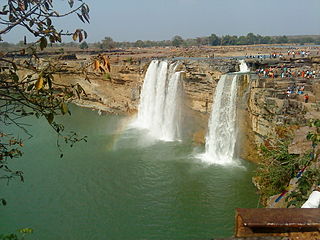
Indravati River is a tributary of the Godavari River, in central India.
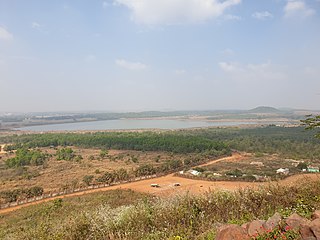
Nabarangpur district, also known as Nabarangapur district or Nawarangpur district, is a district of Odisha, India. The city of Nabarangpur is the district capital. Most of its population is tribal and the land is heavily forested. It borders Kalahandi and Koraput districts. Nabarangpur district is situated at 19.14′ latitude and 82.32′ longitude at an average elevation of 572 metres (1,877 ft).

Dantewada District, also known as Dantewara District or Dakshin Bastar District, is a district in the Indian state of Chhattisgarh. Dantewada is the district headquarters. The district is part of Bastar Division. Until 1998, Dantewada District was a tehsil of the larger Bastar District.

Jagdalpur is a city located in the southern part of Chhattisgarh state in India. It is the administrative headquarters of the Bastar district and Bastar division. Before the independence of India, it also served as the capital of the erstwhile princely state of Bastar. It is the fourth largest city of Chhattisgarh. A city known For its Distinct art and culture, the Tourism capital of Chhattisgarh and one of the Fastest Growing City of State.It is also known as ' Mumbai Of Chhattisgarh ' for its diverse demographics and second biggest financial hub in the state after Raipur.

Dantewada is a town and a municipality, or nagar palika. in the Dantewada district in the state of Chhattisgarh, India.It is the administrative headquarters of Dantewada District. It is the fourth largest city of Bastar division. The town is named after the goddess Danteshwari, the presiding deity of the Danteshwari Temple located in the town, 80 km from the Jagdalpur town. The goddess is worshipped as an incarnation of Shakti and the temple is held to be one of the fifty-two sacred Shakti Peethas. Dantewada Town is well connected by broad gauge railway line from Visakhapatnam. The Nearest Big city to Dantewada is Raipur and well connected with Bus services

Bastar state was a princely state in India during the British Raj. It was founded in the early 13th century by Annamaraja, a brother of the last ruler of the Kakatiya dynasty, Prataparudra II.

Bhoramdeo Temple is a Hindu temples dedicated to the god Shiva in Bhoramdeo, in the Indian state of Chhattisgarh. It comprises a group of four temples of which the earliest is a brick-temple. The main temple is the Bhoramdeo temple built in stone. The architectural features with erotic sculptures has given a distinct style akin to the Khajuraho temple and the Konark Sun Temple in Odisha, and hence the Bhoramdeo complex is known by the sobriquet the "Khajuraho of Chhattisgarh".
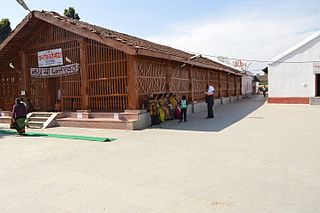
Danteshwari Temple is Hindu temple, dedicated to Goddess Danteshwari, and is one of the 52 Shakti Peethas, shrines of Shakti, the divine feminine, spread across India. The temple built in the 14th century, is situated in Dantewada, a town situated 80 km from Jagdalpur Tehsil, Chhattisgarh. Dantewada is named after the Goddess Danteshwari, the presiding deity of the earlier Kakatiya rulers. Traditionally she is the Kuldevi of Bastar state,

Baijnath Temple is a Nagara style Hindu temple situated in a small town of Baijnath located in Kangra District, Himachal Pradesh, India, and was built in early 13th century by two local merchants named Ahuka and Manyuka. It is dedicated to Shiva as Vaidyanath, ‘the Lord of physicians’. According to the inscriptions on the present day Baijnath temple structure, a temple of Shiva had existed before construction of present-day structure. The inner sanctum houses a Shiva lingam. Further images are carved in the walls and in niches on the exterior.
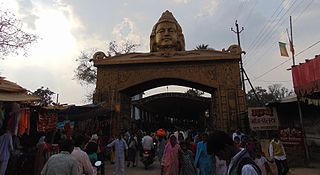
Mahamaya Temple is a Hindu temple, dedicated to Goddess Durga, Mahalaksmi located at Ratanpur of Bilaspur district in Chhattisgarh, India and is one of the 52 Shakti Peethas, shrines of Shakti, the divine feminine, spread across India. Ratanpur is a small city, full of temples and ponds, situated around 25 km from district Bilaspur of Chhattisgarh.Goddess Mahamaya is also known as Kosaleswari, presiding deity of old Daksin Kosal region.
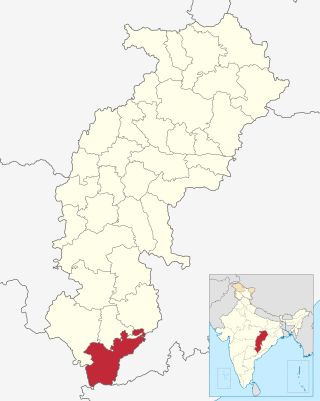
Sukma district is the southernmost district in the Indian state of Chhattisgarh. It is located in the Bastar region, known for its tribal culture. Sukma district borders with Odisha, Telangana and Andhra Pradesh.

Abujhmarh is a hilly forest area, spread over 4,000 square kilometres (1,500 sq mi) in Chhattisgarh, covering Narayanpur district, Bijapur district and Dantewada district. It is home to indigenous tribes of India, including Gond, Muria, Abujhmarhia, Madiya, and Halba. It was only in 2009 that the Government of Chhattisgarh lifted the restriction on the entry of common people in the area imposed in the early 1980s. Geographically isolated and largely inaccessible, the area continues to show no physical presence of the civil administration, and is also known as "liberated-zone" as it is an alleged hub of Naxalite-Maoist insurgency, the banned Communist Party of India (Maoist) and its military wing, People's Liberation Guerilla Army (PLGA), who run a parallel government in the area.
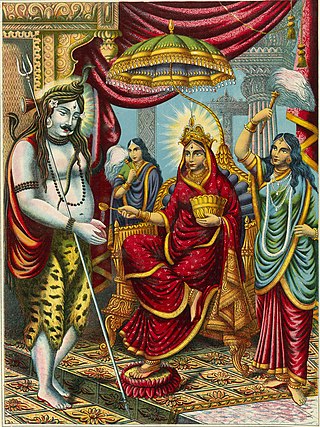
Annapurna Devi Mandir, also known as Annapurna Mata Mandir and Annapurna Mandir, is one of the most famous Hindu temples (Mandir) in the holy city of Varanasi. This temple has great religious importance in Hinduism and is dedicated to the goddess Annapurna. Annapurna is the Hindu goddess for nourishment and is a form of the goddess Parvati. The current Annapurna Mandir was constructed in the 18th century by Maratha Peshwa Bajirao I.

Tourism is an important part of the economy of the Indian state of Chhattisgarh, India's tenth largest state. The state has many ancient monuments, rare wildlife, carved temples, Buddhist sites, palaces, water falls, caves, rock paintings and hill plateaus.
The Nalas were an Indian dynasty that ruled parts of present-day Chhattisgarh and Odisha during the 6th century CE. Their core territory included the areas around Bastar and Koraput districts. Their capital was probably Pushkari, identified with the modern Garhdhanora in Bastar district. At one point, they seem to have conquered the Vakataka capital Nandivardhana in the Vidarbha region, but suffered reverses against the Vakatakas as well as the Chalukyas. Sharabhapuriyas, their northern neighbours, also seem to have played a part in their downfall. They were probably supplanted by the Panduvamshi dynasty, although one branch of the dynasty seems to have ruled a small territory until the 7th or 8th century CE.

Sirpur Group of Monuments are an archaeological and tourism site containing Hindu, Jain and Buddhist monuments from the 5th to 12th centuries in Mahasamund district of the state of Chhattisgarh, India. Located near an eponymous village, it is 78 kilometres (48 mi) east of Raipur, the capital of the state. The site is spread near the banks of the river Mahanadi.
Madvi Hidma is the youngest member of the Central Committee of Communist Party of India (Maoist). Hidma is allegedly responsible for various attacks on the security forces in Chhattisgarh, and the 2013 Naxal attack in Darbha valley. A bounty has been placed for his capture.
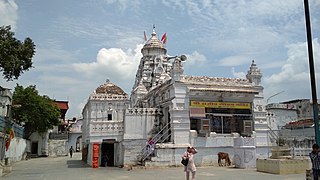
Rajiv Lochan Temple is a temple located in Rajim, in the Indian state of Chhattisgarh. It is dated to the 8th century CE.

The Narayanpal Temple is a historic Hindu temple located near the confluence of the Indravati and Narangi rivers in the Bastar district of Chhattisgarh, India. It is dedicated to the Hindu god Vishnu, the creator and protector of the universe in Hindu mythology. The temple is situated in the village of Narayanpal, about 4 kilometers east of the reputed Chitrakote Falls. The temple was built around 1111 AD by Mumunda Devi, a queen of the Chindaka Naga dynasty. It was built in the Nagara style of Hindu temple architecture and influenced by the Chalukya style as well.


















